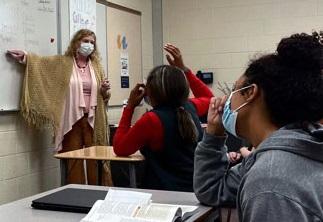A School news Network feature -- Grand Rapids Community College professor Amy Bowling began her Monday morning class at Kenowa Hills High School by requesting help from her students.
“I need you guys to teach me how to set goals,” she said.
Sophomore Clayton Gilbert sounded surprised: “You don’t know how to set goals? You’re the teacher.”
“The best way to learn is to teach somebody else,” the college professor responded.
Although they’re still sophomores in high school, Bowling’s 24 students are dual-enrolled in high school and college. It’s called the middle college program, a new partnership between Kenowa Hills and Grand Rapids Community College.
The Kenowa Hills middle college program is the latest for GRCC. The college also partners with Wyoming, Cedar Springs, East Kentwood, Ottawa Hills High Schools with an associate of Arts degree program; Kent Intermediate School District with an associate of applied arts and sciences - mechanical design program; and the Ottawa Area Intermediate School District and local business partners with a certificate of industrial maintenance or tooling and manufacturing.
To help their professor with her request, the Gilbert used the DAPPS process (dated, achievable, personal, positive, specific) to offer suggestions for goal-setting.
Chloe Dykhouse advised Bowling to break her project into parts and set aside time to work on it each day.
“Plan a date to have it done, because having it done on the day it’s due is not very convenient,” Melody Dibble suggested.
“Having something to motivate you helps you look forward to achieving your goals,” Ray McGaran added.
As they worked, Bowling reminded her students that setting and prioritizing goals is a balancing act.
In life, “you’re going to have simultaneous dreams and goals,” she told them. “We’re in college now; that’s the level we’re at.”
Making College Accessible
Students enrolled in the middle college program have the opportunity to earn a free associate degree in business, technology, or health, in addition to their high school diploma. The high school previously partnered with Davenport University to establish its middle college program in 2013.
“Students who participate in this program go further with their education because they didn’t have to pay for the first two years,” principal Nate Robrahn said. “It gives kids the ability to know they can go to college and do well, and the belief that they can succeed.”
Any student with a minimum 2.5 GPA in their second semester of their freshman year is eligible to apply for the middle college program, regardless of income status or citizenship. All classes are taught by GRCC instructors and completed at the high school until the student’s 13th year, when they will be held at GRCC.
“We cover the costs of the materials and books and work with universities to transfer their credits to schools other than GRCC,” said Kenowa Hills High School Transitions Coordinator Katrina Young. “This program teaches them how to be college students.”
Young also works with GRCC counselors and advisers to connect Kenowa Hills students with tutoring services, library resources and other support services.
Middle college students do not leave high school early, but participate in their high school and college courses simultaneously, Robrahn said.
“They can still go to prom and walk at graduation after their 12th year, but they receive their associate degree after their 13th year,” he said.
The program allows students the time to explore their interests and career goals on “Kenowa Hills’ dime,” Young said.
Program leaders say their main goals are increasing the number of students enrolling in and completing college, reducing the financial burden on families and providing an opportunity for students to engage in an early college experience in a supportive setting.
“Kids are engaged, show up to class and ask more questions because they want to be prepared; it’s a win-win,” Robrahn said. “There’s a reason we talk about opportunities for free education. This stuff works, and it’s the best thing for our students.”
This story was reported by Alexis Stark of the School News Network.
